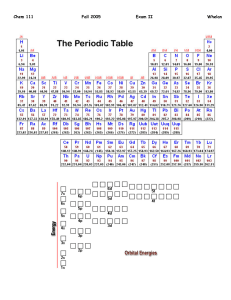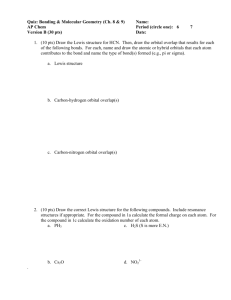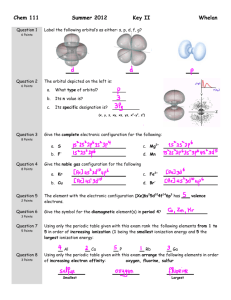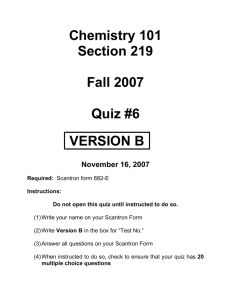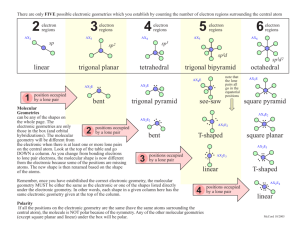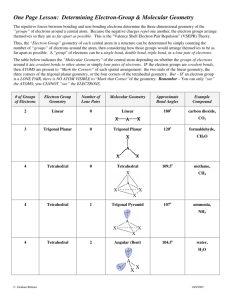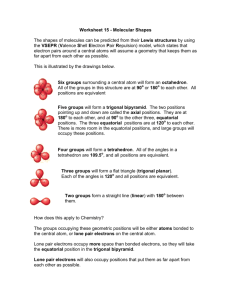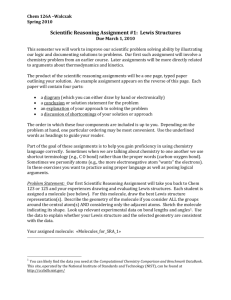Steps for drawing a Lewis structures and determining geometry
advertisement
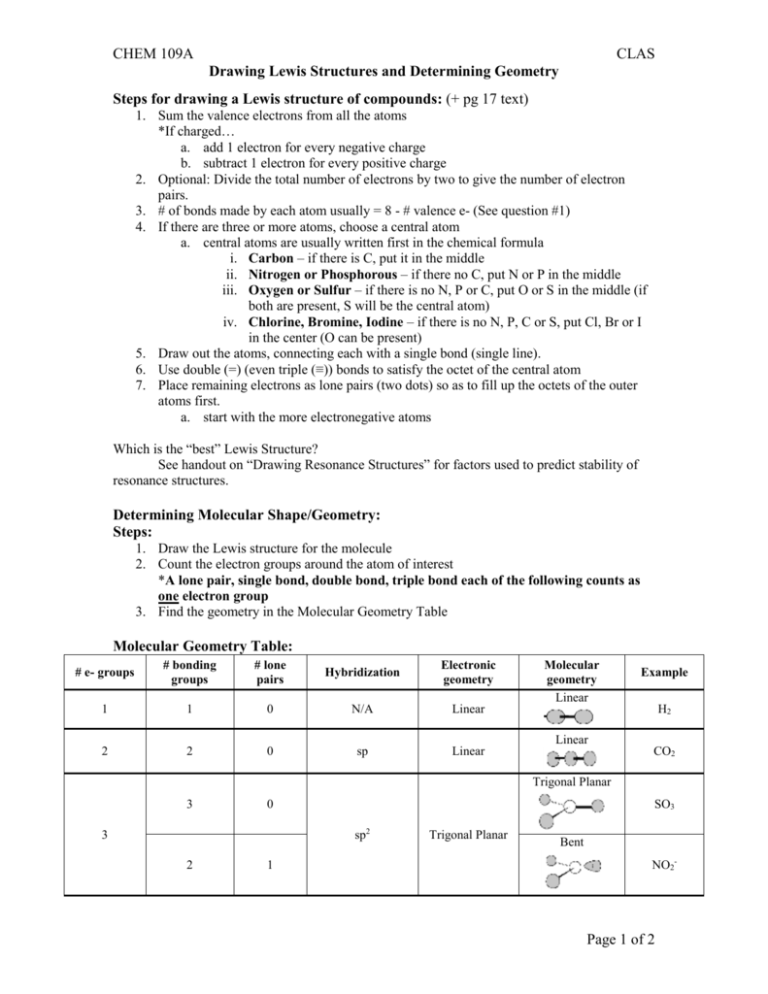
CHEM 109A CLAS Drawing Lewis Structures and Determining Geometry Steps for drawing a Lewis structure of compounds: (+ pg 17 text) 1. Sum the valence electrons from all the atoms *If charged… a. add 1 electron for every negative charge b. subtract 1 electron for every positive charge 2. Optional: Divide the total number of electrons by two to give the number of electron pairs. 3. # of bonds made by each atom usually = 8 - # valence e- (See question #1) 4. If there are three or more atoms, choose a central atom a. central atoms are usually written first in the chemical formula i. Carbon – if there is C, put it in the middle ii. Nitrogen or Phosphorous – if there no C, put N or P in the middle iii. Oxygen or Sulfur – if there is no N, P or C, put O or S in the middle (if both are present, S will be the central atom) iv. Chlorine, Bromine, Iodine – if there is no N, P, C or S, put Cl, Br or I in the center (O can be present) 5. Draw out the atoms, connecting each with a single bond (single line). 6. Use double (=) (even triple (≡)) bonds to satisfy the octet of the central atom 7. Place remaining electrons as lone pairs (two dots) so as to fill up the octets of the outer atoms first. a. start with the more electronegative atoms Which is the “best” Lewis Structure? See handout on “Drawing Resonance Structures” for factors used to predict stability of resonance structures. Determining Molecular Shape/Geometry: Steps: 1. Draw the Lewis structure for the molecule 2. Count the electron groups around the atom of interest *A lone pair, single bond, double bond, triple bond each of the following counts as one electron group 3. Find the geometry in the Molecular Geometry Table Molecular Geometry Table: # e- groups # bonding groups # lone pairs Hybridization Electronic geometry 1 1 0 N/A Linear 2 2 0 sp Linear Molecular geometry Linear Example H2 Linear CO2 Trigonal Planar 3 0 SO3 sp2 3 2 1 Trigonal Planar Bent NO2- Page 1 of 2 CHEM 109A CLAS Drawing Lewis Structures and Determining Geometry Tetrahedral 4 0 CH4 Trigonal Pyramidal 3 1 NH3 sp3 4 Tetrahedral Bent/angular 2 2 H2O Linear 1 3 HCl Draw here Summary of Hybridization # bond bond % s-character bond bonds length strength hybridization angle 1 sp3 25% 109.5o 2 2 sp 33.3% 120o 3 sp 50% 180o *Exceptions: ammonia – one lone pair causes bond angles to be less than 109.5o (107.3o actually) water - two lone pairs cause bond angle to be less than 109.5o (104.5o actually) ↑ ↓ ↑ ↓ Polar vs. nonpolar Need to look at bond polarity/nonpolarity as well as molecular geometry. H 2.1 Li 1.0 Na 0.9 K 0.8 Rb 0.8 Cs 0.7 Electronegativities (EN) Be 1.5 Mg 1.2 Ca 1.0 Sr 1.0 Ba 0.9 B 2.0 Al 1.5 Ga 1.6 In 1.7 Tl 1.8 C 2.5 Si 1.8 Ge 1.8 Sn 1.8 Pb 1.9 N 3.0 P 2.1 As 2.0 Sb 1.9 Bi 1.9 O 3.5 S 2.5 Se 2.4 Te 2.1 Po 2.0 F 4.0 Cl 3.0 Br 2.8 I 2.5 At 2.1 Difference in EN: Bond Type EN difference Covalent 0-0.4 Polar Covalent 0.5-1.7 Ionic 1.8 + Flow Chart Does the molecule have polar covalent bonds? Yes No Is the Lewis structure symmetrical? Nonpolar Yes No Nonpolar Polar Page 2 of 2
